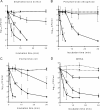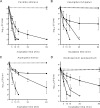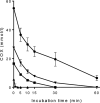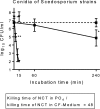Bactericidal and Fungicidal Activity of N-Chlorotaurine Is Enhanced in Cystic Fibrosis Sputum Medium
- PMID: 28223376
- PMCID: PMC5404548
- DOI: 10.1128/AAC.02527-16
Bactericidal and Fungicidal Activity of N-Chlorotaurine Is Enhanced in Cystic Fibrosis Sputum Medium
Abstract
Lung infections with multiresistant pathogens are a major problem among patients suffering from cystic fibrosis (CF). N-Chlorotaurine (NCT), a microbicidal active chlorine compound with no development of resistance, is well tolerated upon inhalation. The aim of this study was to investigate the in vitro bactericidal and fungicidal activity of NCT in artificial sputum medium (ASM), which mimics the composition of CF mucus. The medium was inoculated with bacteria (Staphylococcus aureus, including some methicillin-resistant S. aureus [MRSA] strains, Pseudomonas aeruginosa, and Escherichia coli) or spores of fungi (Aspergillus fumigatus, Aspergillus terreus, Candida albicans, Scedosporium apiospermum, Scedosporium boydii, Lomentospora prolificans, Scedosporium aurantiacum, Scedosporium minutisporum, Exophiala dermatitidis, and Geotrichum sp.), to final concentrations of 107 to 108 CFU/ml. NCT was added at 37°C, and time-kill assays were performed. At a concentration of 1% (10 mg/ml, 55 mM) NCT, bacteria and spores were killed within 10 min and 15 min, respectively, to the detection limit of 102 CFU/ml (reduction of 5 to 6 log10 units). Reductions of 2 log10 units were still achieved with 0.1% (bacteria) and 0.3% (fungi) NCT, largely within 10 to 30 min. Measurements by means of iodometric titration showed oxidizing activity for 1, 30, 60, and >60 min at concentrations of 0.1%, 0.3%, 0.5%, and 1.0% NCT, respectively, which matches the killing test results. NCT demonstrated broad-spectrum microbicidal activity in the milieu of CF mucus at concentrations ideal for clinical use. The microbicidal activity of NCT in ASM was even stronger than that in buffer solution; this was particularly pronounced for fungi. This finding can be explained largely by the formation, through transhalogenation, of monochloramine, which rapidly penetrates pathogens.
Keywords: N-chlorotaurine; anti-infective; antimicrobial; antiseptic; cystic fibrosis; lung.
Copyright © 2017 American Society for Microbiology.
Figures




References
-
- Marshall BC, Elbert A, Petren K, Rizvi S, Fink A, Ostrenga J, Sewall A. 2015. Cystic Fibrosis Foundation patient registry: annual data report 2014. Cystic Fibrosis Foundation, Bethesda, MD.
MeSH terms
Substances
Grants and funding
LinkOut - more resources
Full Text Sources
Other Literature Sources
Medical
Molecular Biology Databases

